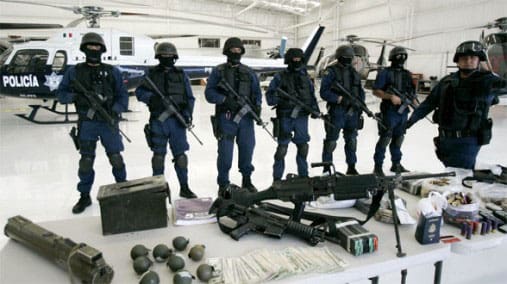Click here to download the Bureau of Alcohol, Tobacco, Firearms and Explosives’ (and big fires, don’t forget big fires) new and improved Project Gunrunner strategy, designed to stem the flow of illegal guns from the U.S. to Mexico. The document affirms one of our main themes on this story: the ATF’s efforts are part of an enormous cluster-you-know-what: a farrago of federal, state, local and Mexican law enforcement agencies working disharmoniously to force cash-rich cartels to source their weapons away from the U.S. – Mexican border. Like THAT’S going to be a problem. Deep breath. Here we go . . .
Even a quick skim of this magnum opus reveals that the ATF can’t get out of its own way. As part of the new plan, seven new ATF branch offices ($37.5 million for starters) can launch their own investigations into local gun running—unless their efforts involve one of three specific drug cartels.
All ATF field divisions are expected to initiate investigations on cartels and/or their surrogates operating in their geographic areas of responsibility; however, investigations pertaining to the Gulf, Zetas, and Sinaloa cartels must be deconflicted and closely coordinated with the Houston and Phoenix Field Divisions.
Deconflicted? What I wouldn’t give to be a fly on the wall at an official ATF and Sometimes E deconfliction meeting . . .
We’ve building a case against Juan Jimenez. Is Juan a Zeta? No, but he has a cousin in Zeta. He married a Gulf. Well, her brother was a Gulf. Is he Juan too? If I was a Zeta, I wouldn’t have married her. I wouldn’t want there to be a Gulf between us. I pledged Sigma Psi Zeta at Yale. Focus people! O.K. Phoenix can have Jimenez. But we want a pass on a Sinaloa in return. Are you kidding? That’s got to be worth at least two Zetas.
But wait! There’s more! More agencies! More deconfliction!
This approach requires conducting our border-related firearms and explosives investigations in a more creative and comprehensive manner by fully incrporating [sic] our agency’s investigative, analytical, technical, and legal capabilities and resources, as well as those available from other law enforcement agencies, particularly DEA. At the heart of this increased emphasis on cartel focused investigations is greater use of the Organized Crime Drug Enforcement Task Force (OCDETF) program and intelligence capabilities available from the El Paso Intelligence Center (EPIC) and the DEA Special Operations Division. Recent changes to OCDETF program policy encourage the use of OCDETF in firearms trafficking cases provided there is a nexus to high value drug trafficking targets.
So who decides if there’s a sufficient nexus? You do know that the ATF also needs to deconflicteramos con los policias federales de Mexico? Luckily, there’s a separate structure for Mexican ops with its own acronym (or two): the ATF Mexico Country Office (MCO), a component of the Office of International Affairs (IAO).
Not to mention the fact that the ATF has to work within the structures established by the U.S. Office of National Drug Control Policy (ONDCP) whose “strategy includes the goals of improving intelligence and information sharing relating to weapons trafficking among Federal, State, local, and tribal law enforcement partners.”
Tribal? Did I forget tribal police? How could I forget them? Noted. Back to the OCDETF (Organized Crime Drug Enforcement Task Force) for a mo.
All ATF field divisions with an OCDETF strike force must consider assigning a complement of special agents to the multi-agency strike force and/or establishing a collocated ATF-led OCDETF group within the strike force.
Any chance the ATF could combine their field divisions’ deconfliction meetings with the ATF-led OCDETF collocation deliberations? I didn’t think so. Anyway, is that everybody?
Additionally, in June 2009, ATF and Immigration and Customs Enforcement (ICE) initiated a Memorandum of Understanding (MOU) intended to address areas of mutual concern and responsibility. To the extent possible, this revised cartel focused strategy will conform to agreements between ATF and ICE and other law enforcement partners that may exist.
So the ATF needs to coordinate with law enforcement partners they don’t even know exist? I suppose that makes sense. You know; when contextualized within the parameters of the coordination efforts mandated by the existing interagency matrix, and the expansion of that matrix to include agencies sharing the same operational initiatives on the local, state, national, tribal and international level.
Oh, I almost forgot the revised cartel strategy mentioned above. The ATF says they’re going after the big fish. Straw purchasers won’t get a pass, but they’ll be encouraged to rat out their bosses (as if). And there’s another big fish: America’s federally licensed firearms dealers (FFLs). Look out guys, here they come!
On occasion, FFLs become targets of criminal investigation and prosecution. When criminal wrongdoing by FFLs is suspected they will be aggressively investigated and recommended for prosecution. Corrupt FFLs constitute high-value targets due to the damage they cause and the special responsibility they hold to ensure that firearms are not illegally diverted from lawful commerce. The potential damage to public safety caused by even one corrupt FFL is difficult to calculate. In the meantime, we will continue to inspect FFLs who serve as a source of firearms to Mexican cartels according to an intelligence driven inspection plan and actively pursue investigative leads developed by industry operations investigators.
High value targets? That ought to make our hard-working, tax-paying gun dealers happy. And here, finally, is the end of the report. If you wanted reassurance that all these agencies and offices and divisions and agents and computers and countries and stuff will work together as a team, this ain’t it.
The new Firearms Operations Division (FOD) in the Office of Field Operations will monitor cartel focused investigations and where appropriate, help coordinate multi- division, multi-agency, and multi-national investigative efforts. These FOD activities will be led by the Southwest Border National Coordinator, who will communicate with senior leadership, field management, and ATF intelligence assets based on linkages between seemingly unrelated cases or fragments of intelligence pertaining to firearms trafficking and border violence by targeted DTOs.
The English have an expression “Using a jackhammer to open a walnut.” I’m not saying that all this ATFE (and big fires) bureaucracy is nuts, but I am saying that complexity makes institutions slow, expensive, vulnerable to security breaches and ineffective.
The ATF could very well be making things worse for efforts to curtail gun running, not better.





If they significantly curtailed gun running wouldn't they be out of a job?
Those weapons are not from your local gun shop. The best way to stem the illegal flow of weapons into Mexico is to stop selling weapons to the corrupt Mexican government.
"So the ATF needs to coordinate with law enforcement partners they don’t even know exist? I suppose that makes sense. You know; when contextualized within the parameters of the coordination efforts mandated by the existing interagency matrix, and the expansion of that matrix to include agencies sharing the same operational initiatives on the local, state, national, tribal and international level."
Wait, what?
With FULLY Auto AK’s at less than$50 each, in the Horn of Africa and out of Mr. Chavez’ country, You’re telling me the USA is to blame- or even a major “player” in the Arms Trade?
I was born at night- BUT NOT LAST NIGHT
Comments are closed.